Carillion: Difference between revisions
No edit summary |
|||
| (48 intermediate revisions by 5 users not shown) | |||
| Line 1: | Line 1: | ||
''<b> | ''<b> Carillon <br> </b>'' | ||
''Osmena Avenue, Diliman, Quezon City, National Capital Region, Philippines <br />'' | ''Osmena Avenue, Diliman, Quezon City, National Capital Region, Philippines <br />'' | ||
== I. Overview == | == I. Overview == | ||
| Line 21: | Line 9: | ||
The University of the Philippines Memorial Campanille is a musical instrument | The University of the Philippines Memorial Campanille is a musical instrument which originally consisted of 46 tuned bells<sup>1</sup> in a 130-foot tower and was sounded by the hammer keys of a clavier, controlled by means of a keyboard or a clockwork mechanism. When it played, the sound of the bells can be heard from all four corners of the campus - classrooms, laboratories, janitorial closets. | ||
The bells used to be played daily during Carlos P. Romulo's term as U.P. President. Every morning at seven thirty [7:30AM], the National Anthem and U.P. Beloved would ring across the campus. This was followed by half an hour of inspiring music, which was repeated at five thirty in the afternoon [5:30PM]. | |||
Today, however, the UP Carillon automatically marks every hour of the day, and is pre-set to dedicate an hour to playing songs—old and modern alike—at five in the afternoon [5PM]. This change in the method of playing is due to the fact that the 36 new bells that have been installed in place of the 46 old ones are hooked-up to a computerized operation system which allows the carillon to play by itself. | |||
Besides it being a time-keeper and a fount of gentle music from a distance, it is also a landmark and a memorial to the spirit of the U.P. Alumni, living and dead. | |||
== II. History == | == II. History == | ||
During the 1940’s, UP President Bienvenido M. Gonzales, Architect Juan Nakipil, and Conservatory Director Ramon Tapales talked about building a Carillon Tower in the campus. Unfortunately, World War II occurred, making the project impossible to execute. However on September 18, 1948, the plan was re-envisioned during a meeting of the board of directors of the UP Alumni Association, after the school was moved to Diliman. | |||
[[Image:Carillon 1.jpg|300px|thumb|left| The U.P. Memorial Campanille in the 1950s]] | [[Image:Carillon 1.jpg|300px|thumb|left| The U.P. Memorial Campanille in the 1950s]] | ||
The budget goal for the tower was around 90,000 Php and 21, 706 Php was accumulated by April 1952. President Elpidio Quirino donated a thousand pesos and Professor Juan Nakpil, the architect for the tower, donated five thousand pesos in memory Dr. Ariston Bautista Lin. Other donors are Vice President Lopez, Eugenio Perez, the 1949 graduating class, inter-fraternity council, the UP Student Council, UP Alumni Chapters Laguna and Tarclas, Former regent Jose F. Zamora, Juan Carlos, The College of Forestry Alumni, Philippine Alpha Chpater of Pan Xenia, an anonymous donor, and many others. | |||
President Elpidio Quirino | |||
[[Image:Carillon 4.jpg|250px|thumb|left| An areal view of the campus from the side of Balara]] | |||
Dutch Carilloneur Adrian Antonisse, Jr. delivered the bells on behalf of Van Bergen Bell. Chimes and Carillon Foundry Company on June 1952 and the last bell was placed on July 11, 1952. The 45-bell carillon was the first of its kind in Southeast Asia and they cost seventy thousand pesos. Finally, Elpidio Quirino inaugurated the Carillon Tower at August 1, 1952 and the entire structure was dedicated to Philippine President Manuel L. Quezon. The UP Conservatory of Music also presented Antonisse at a Carillon concert on August 3, 1952 and he was also given a farewell concert on August 14. Carilloneurs Eva Gonzales and Wesley Tubuyoyong took turns in playing the bells at the tower that same year. | |||
== III. Structure and Design == | == III. Structure and Design == | ||
'''Structure Overview''' | '''Structure Overview''' | ||
<br />Generally constructed for bell towers,carillons are the heaviest of all extant musical | <br />Generally constructed for bell towers,carillons are the heaviest of all extant musical instruments. The bells are usually made from bronze (80% copper + 20% tin) to produce perfect tone and clarity. Bronze is also much less prone to corrosion and much harder than brass thereby allowing carillons to retain its quality for decades. Carillons are connected through wires to the playing cabin where the clavier is installed. The playing cabin is positioned directly below the bell-chamber so the clavier can be placed in the optimum position relative to the transmission system. The entire system is then housed inside a tower to protect and support the instrument. | ||
<br />'''The Tower''' | <br />'''The Tower''' | ||
<br />The University of the Philippines Memorial Campanile is a 130- | <br />The tower which houses at its highest level the bells of the University of the Philippines Memorial Campanile is a 130-feet-tall structure. It was built under the supervision of architect Juan Nakpil, who was hailed as National Artist for Architecture in 1973. The funds for its construction were provided by the UP Alumni Association and certain donors. | ||
The exterior walls of the tower are painted with cream and maroon. It has a very stable foundation and has a system of vertical lines (eight outside, four inside) supporting the structure. The top portion of the tower is an open bellchamber with a small dome ceiling. It houses and displays the bells to the public. A sight of an endless narrow spiral staircase skyward through 5 landings could be seen in the building’s interior. During the First Quarter Storm in 1970’s, the UP Carillon was used as a watchtower by student activists—its unusual height provided the activists a panoramic view of the campus, which enabled them to spot military trying to barge in. | |||
<br />'''The Bells''' | <br />'''The Bells''' | ||
<br />46 bells were installed | <br />46 bells were originally installed at the top portion of the tower under the supervision of Professor Adrian Antonisse Jr., a Dutch carilloneur and director of Veendammer Muziekschool in the Netherlands. Those bells were casted by Van Bergen Bell, Chimes and Carillon Foundry. Some of the bells were named after individual donors. On the largest bell—weighing about 5 tons—was embossed the names of the officers and the members of the board of directors of the alumni association. The last bell was set place on July 11, 1952. | ||
These bells were tuned to the intervals of the chromatic scale similar to a piano, and having a range of three octaves or more. The bell which has the lowest pitch can weigh many tons. The smaller the size of the bell means the higher the pitch. | |||
The classic method of playing the carillon is by striking a keyboard called a “clavier” which is similar to an organ except that it uses wooden pegs. According to Prof. Antonisse, one to two years of devoted study is necessary to master the instrument and that it also requires a great deal of muscular effort to play the instrument because the fists (rather than fingers) are used in striking the keys. Each key of the clavier is connected to the clapper of the corresponding bell by means of wires and cranks. Those clappers are sufficient to bring out the full volume of sound required for carillon playing. Pedals are also attached to the levers connected with the heavier bells so that these can be played by foot. | |||
However, as part of UP Alumni Association’s project to restore the UP Carillon in 2008, these 46 old bells have been replaced by 36 new bells that were manufactured by Royal Bell Foundry Petit & Fritsen B.V. Holland. Aside from that, recent development has also allowed for an alternative way of playing the carillon by means of an automatic machine which enables the carillon to play at pre-set hours. The old bells are currently on display at the lobby of the University Theater. | |||
| Line 82: | Line 54: | ||
! First Five Carilloneurs | ! First Five Carilloneurs | ||
|- | |- | ||
| | | Adrian Antonisse Jr. | ||
|- | |- | ||
| | | Wesley Tubuyoyong | ||
|- | |- | ||
| | | Eva Gonzales | ||
|- | |- | ||
| Jerry Dadap | | Jerry Dadap | ||
| Line 95: | Line 67: | ||
Table 1 shows the first five Carilloneur of the University of the Philippines. Currently [2011-2012], U.P. Carilloneurs are Malvin Bethooven Macasaet, Bachelor of Music [BM] Conducting graduate pursuing his 3rd degree in BM in Voice, and Jesper Colleen Mercado, BM Piano, both from the U.P. College of Music. | Table 1 shows the first five Carilloneur of the University of the Philippines. Currently [2011-2012], U.P. Carilloneurs are Malvin Bethooven Macasaet, Bachelor of Music [BM] Conducting graduate pursuing his 3rd degree in BM in Voice, and Jesper Colleen Mercado, BM Piano, both from the U.P. College of Music. | ||
== IV. Symbolisms and Struggles == | == IV. Symbolisms and Struggles == | ||
| Line 102: | Line 72: | ||
<b> | <b>Loyalty and Connection Between Generations</b> | ||
Since it was the alumni association who mainly contributed in the construction of the Carillon, it was established that the tower symbolizes the | Since it was the alumni association who mainly contributed in the construction of the Carillon, it was established that the tower symbolizes the alumni spirit of love and loyalty for the university. As said by Juan Nakpil, the Carillon will serve as the emotional and spiritual link between the students, faculty, and alumni of the succeeding generations. He also added, “It will be a voice speaking to us [in] the midst of our campus – not from a distance.” | ||
<b> | <b>Extravagance</b> | ||
Though UP Carillon has been a symbol for alumni’s labor of love, it did not escape criticisms regarding its formation and structure. During the time of its construction, the state university was also suffering from an immense financial difficulty brought about by the war. Because of this, some sectors of the university objected to the formation of the Carillon, calling it a symbol of extravagance instead of loyalty. They contested that the money spent for its construction should have been allotted in solving the monetary problems that plagued the university. | |||
In response to this, the editor of the Collegian | In response to this, the editor of the Philippine Collegian during that time wrote: “We do not look at it that way. To us, the Carillon is a gift of the alumni and is symbolic of their regard to the Alma Mater. To us, the Memorial Campanile is the expression of their loyalty to the cause of education which the University is dedicated. That to us is the Carillon. If loyalty ever be a luxury then the Carillon and all that it stands for is luxury, indeed.” | ||
Most of the University Officials believed that the Carillon symbolizes very important ideas and | Most of the University Officials believed that the Carillon symbolizes very important ideas and concepts that are priceless and are worthy of the enormous amount spent for its construction. | ||
<b> | <b>Being Tilted</b> | ||
The Carillon became | The Carillon became sparked interest not only because of its opulence but also because of the assumption that the structure is tilted. During that time, students of the university hoped to have another leaning tower like that of the Pisa in Italy. However, a study made by a group of engineering professors proved that it was just an optical illusion. It was only after this study that all the clamor ceased. | ||
<b> | <b>Out of Tune</b> | ||
Aside from the fact that the bells are tuned in chromatic intervals and have a range of three or more octaves, the overtones and the harmonics produced by the bells are also arranged in an order | Aside from the fact that the bells are tuned in chromatic intervals and have a range of three or more octaves, the overtones and the harmonics produced by the bells are also arranged in an order quite different from those given by the strings or by an organ. Because of these factors, listeners who are not familiar with the Carillon would think that our bells are out of tune. | ||
Defending the Carillon, Arthur L. Bigelow said, | Defending the Carillon, Arthur L. Bigelow said, “In contrast to other producers of musical tone, endowed by nature with a major third, the third of the bell is minor. It is this particular overtone which gives to the bell its plaintive note, so characteristic and so distinctive from all other instruments.” | ||
Truly, before one can fully appreciate the music of the Carillon, he must first learn to distinguish the humtones from the overtones. As what Prof Antonisse has said in one of his lectures, “You just don’t take Carillon Music. It is entirely different from other forms of music.” | |||
<b>Timelessness and Identity</b> | |||
This all being said, the Carillon stands tall and proud to this day. Despite the criticisms and calamities that it has seen throughout the years, the its legacy (and that of the alumni who have contributed to its building and rehabilitation) lives on. The Carillon tower is a permanent landmark and is arguably as "UP" as the other famous spots within the campus--thereby securing its place in history and identity of the university. | |||
== V. Restoration == | == V. Restoration == | ||
| Line 140: | Line 112: | ||
Due to age and neglect, the Carillon fell silent through the years. Though the tower remained firm and robust, the Holland-made bronze bells went out of tune and the clavier crumbled over time. It was during the Lantern Parade in 1988 that the Carillon was last heard. Since then, the tower had been used as a stockroom, an art studio, and other various purposes. Previous restorations fell short of the funds needed for a complete overhaul. | |||
The U.P. Alumni Association [UPAA] thought of bringing back the "Bells of Diliman" in time for the University's Centennial Celebration in 2008. During the 92nd Alumni Homecoming in June 2005, the UPAA Board of Directors officially launched the U.P. Carillon Restoration Project. | |||
The Projet Committee's main objectives included the following: [1.] to restore the campanile, the tower, and the surroundings, which involves technical evaluations, fund raising, actual repairs and replacements, and the landscaping of the immediate environs; and [2.] to institutionalize the Carillon's operation and maintenance. Aside from preserving the bells' musicality and the physical upkeep, the project included maintaining a scholarship to ensure the availability of a steady pool of well-trained carilloneurs. Below are some of the renovations and changes made<sup>4</sup>: | |||
The Projet Committee's main objectives | |||
[[Image:Carillon 9.JPG|200px|thumb|left| U.P. Carillon in sad state of decay]] | [[Image:Carillon 9.JPG|200px|thumb|left| U.P. Carillon in sad state of decay]] | ||
| Line 152: | Line 122: | ||
<blockquote> | <blockquote> | ||
1. ''' | 1. '''Clavier'''. The old clavier keyboard instrument was replaced with a new one made of oak wood and designed for heavy-duty performances. | ||
</blockquote> | </blockquote> | ||
<blockquote> | <blockquote> | ||
2 | 2. '''Computerized operation'''. In addition to manual playing of the clavier, it is now hooked-up to a master clock, a synthesizer, and a computer. This enables the bells to be played automatically at specific times of the day. | ||
</blockquote> | </blockquote> | ||
| Line 166: | Line 132: | ||
[[Image:Carillon 13.JPG|150px|thumb|rignt| Philippine Daily Inquirer. December 5, 2007]] | [[Image:Carillon 13.JPG|150px|thumb|rignt| Philippine Daily Inquirer. December 5, 2007]] | ||
<blockquote> | <blockquote> | ||
3. '''Steel frames and other parts'''. The steel frames where the bells are suspended were refurbished. Other important parts such as clappers, cables and steel wires, turnbuckle nuts and bolts, spindle springs, and miscellaneous items were replaced. | |||
</blockquote> | </blockquote> | ||
<blockquote> | <blockquote> | ||
5. '''Tower structure'''. Both the inside and the outside walls of the Carillon tower, the flooring and other concrete structures were repaired, cleaned, and repainted. | |||
</blockquote> | </blockquote> | ||
<blockquote> | <blockquote> | ||
6. '''Landscaping'''. The areas that surround the Carillon tower were cleaned, grass and flowering plants will be placed in accordance with a well laid-out plan. | |||
</blockquote> | </blockquote> | ||
<blockquote> | <blockquote> | ||
7. '''Carillon Plaza'''. The outer surrounding areas encircling the Carillon tower were transformed into a flat amphitheater-like formation where concerts and musical performances could be held. | |||
</blockquote> | </blockquote> | ||
Past minor repairs were in 1977 for the University's Silver Jubilee and in 1982 for the University's Diamond Jubilee. | Past minor repairs were also done in 1977 for the University's Silver Jubilee and in 1982 for the University's Diamond Jubilee. | ||
== VI. Other Projects == | == VI. Other Projects == | ||
[[Image:Carillon 8.JPG|100px|thumb|left| "Kampana": a concert for the restoration of the U.P. Carillon]] | [[Image:Carillon 8.JPG|100px|thumb|left| "Kampana": a concert for the restoration of the U.P. Carillon]] | ||
[[Image:Carillon 14.JPG| | [[Image:Carillon 14.JPG|200px|thumb|left|ladies' shawls witha "callado" painting by Choleng]] | ||
Along with the restoration came various projects and events for the U.P. Carillon Tower. One project is the ''"Kampana: Pagsamba... Pagbabago... Pagdiriwang"'' featuring the University of the Philippines Madrigal Singers<sup>5</sup> [Madz] held on December 17, 2006 at the Cultural Center of the Philippines [CCP], Tanghalang Nicanor Abelardo. The concert was not planned, hence, a coincidence, when Mark Anthony Carpio, choirmaster of the group, conceptualized a Christmas concert about bells of worship, bells of change, and bells of celebration. It was a surprise to the UPAA, and thought of buying one of the Madz's concerts as a fund raiser for the restoration of the U.P. Carillon. In line with that, U.P. Coeds don the Araceli Limcaco-Dans designed shawls for the ''Kampana'' concert, that is, with a ''callado'' painting. | Along with the restoration came various projects and events for the U.P. Carillon Tower. One project is the ''"Kampana: Pagsamba... Pagbabago... Pagdiriwang"'' featuring the University of the Philippines Madrigal Singers<sup>5</sup> [Madz] held on December 17, 2006 at the Cultural Center of the Philippines [CCP], Tanghalang Nicanor Abelardo. The concert was not planned, hence, it was a coincidence, when Mark Anthony Carpio, choirmaster of the group, conceptualized a Christmas concert about bells of worship, bells of change, and bells of celebration. It was a surprise to the UPAA, and thought of buying one of the Madz's concerts as a fund raiser for the restoration of the U.P. Carillon. In line with that, U.P. Coeds don the Araceli Limcaco-Dans designed shawls for the ''Kampana'' concert, that is, with a ''callado'' painting. | ||
== VII. Bibliography == | == VII. Bibliography == | ||
Cabatuando, Patria. "The Musical Tower". <i>The Philippine Collegian</i>. 14 October 1967. | |||
“Carillon.” <i>UP Newsletter</i> 19 October 1973. A1. Print. | |||
"Carillon on the Diliman Skyline". <i>The UP Bulletin</i>. August 1949. A1. Print. | |||
"Carilloneur Speaks on Bells and Music". <i>The UP Bulletin</i>. July 1952. A1. Print. | |||
“Legend of the Bells.” <i>The UP Bulletin</i> September 1952. A1. Print | |||
Mendoza, Rene E. "The Carillon Story". <i>The Carillon Overtones | Mendoza, Rene E. "The Carillon Story". <i>The Carillon Overtones</i>. March 1957. A1. Print. | ||
Nakpil, Juan F. "The Bells of Diliman." | |||
<i>The New Grove Dictionary of Music and Musicians.</i> Ed. S. Sadie. 3 Vols. | |||
"Carillon". <i>The UP | "Now on its way are the UP Carillon Bells". <i>The UP Bulletin, Alumni Homecoming Volume </i>. April 1952. A1. Print. | ||
<i>Philippine Daily Inquirer</i> 5 December 2007. A1. Print. | |||
<i>Philippine Star Lifestyle</i> 12 September 2005 A1. Print. | |||
"Quirino Donates P 1,000 to Carillon". <i>The UP Bulletin</i> August 1949. A1. Print. | |||
" | Rivera, Flora Zarco. "The UP Carillon Bells". <i>UP Alumni Reunion Yearbook</i>. 1953. Print. | ||
"Save The U.P. Carillon: A Centennial Project of the U.P. Alumni Association". Pamphlet. 2005. Print. | |||
Valmero, Anna. "Restored UP Carillon serenades students once more". <i>Yahoo! News Philippines</i>. 18 April 2011. | |||
<i>The UP Bulletin</i> January 1950. A1. Print. | |||
==Map== | ==Map== | ||
| Line 248: | Line 194: | ||
== See Also == | == See Also == | ||
[[Public Art at UP Diliman]] | *[[Public Art at UP Diliman]] | ||
*[http://www.gcna.org/documents/tower-construction.pdf]Standard for Constructing Carillon Towers | *[http://www.gcna.org/documents/tower-construction.pdf]Standard for Constructing Carillon Towers | ||
* U.P. Carillon Music and Photos ''http://www.youtube.com/watch?v=BnukWQqbqzY'' | * U.P. Carillon Music and Photos [Before and After the Restoration] ''http://www.youtube.com/watch?v=BnukWQqbqzY'' | ||
* Inquirer.net [2007] [[http://showbizandstyle.inquirer.net/lifestyle/lifestyle/view/20070609-70321/Restoring_the_UP_Carillon%92s_history]] | * Inquirer.net [2007] [[http://showbizandstyle.inquirer.net/lifestyle/lifestyle/view/20070609-70321/Restoring_the_UP_Carillon%92s_history]] | ||
* Inquirer.net [2008] [[http://showbizandstyle.inquirer.net/entertainment/entertainment/view/20080112-111831/The_UP_Carillon_rings_again]] | * Inquirer.net [2008] [[http://showbizandstyle.inquirer.net/entertainment/entertainment/view/20080112-111831/The_UP_Carillon_rings_again]] | ||
| Line 259: | Line 205: | ||
Footnotes: | Footnotes: | ||
<sup>1</sup> as per all write-ups of the U.P. Alumni Asociation or UPAA [booklets, pamphlets, press releases, etc.] | <sup>1</sup> as per all write-ups of the U.P. Alumni Asociation or UPAA [booklets, pamphlets, press releases, etc.] | ||
| Line 266: | Line 213: | ||
<sup>4</sup> for more information, you may visit [[www.upcarillon.org]] | <sup>4</sup> for more information, you may visit [[www.upcarillon.org]] | ||
<sup>5</sup> The Philippine Madrigal Singers or Madz was organized in 1963 by National Artist Professor Andrea Veneracion. The choir is one of the most awarded, having consistently won all the top prizes in most of the world's prestigious choral competitions. | |||
Latest revision as of 17:42, 3 October 2013
Carillon
Osmena Avenue, Diliman, Quezon City, National Capital Region, Philippines
I. Overview
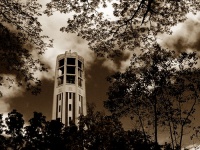
According to the "New Grove Dictionary of Music and Musicians", a carillon (n.) is a set of stationary bells normally in a tower or high outdoor frame, for playing music.
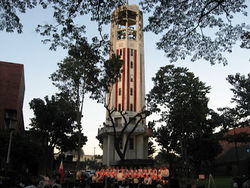
The University of the Philippines Memorial Campanille is a musical instrument which originally consisted of 46 tuned bells1 in a 130-foot tower and was sounded by the hammer keys of a clavier, controlled by means of a keyboard or a clockwork mechanism. When it played, the sound of the bells can be heard from all four corners of the campus - classrooms, laboratories, janitorial closets.
The bells used to be played daily during Carlos P. Romulo's term as U.P. President. Every morning at seven thirty [7:30AM], the National Anthem and U.P. Beloved would ring across the campus. This was followed by half an hour of inspiring music, which was repeated at five thirty in the afternoon [5:30PM]. Today, however, the UP Carillon automatically marks every hour of the day, and is pre-set to dedicate an hour to playing songs—old and modern alike—at five in the afternoon [5PM]. This change in the method of playing is due to the fact that the 36 new bells that have been installed in place of the 46 old ones are hooked-up to a computerized operation system which allows the carillon to play by itself.
Besides it being a time-keeper and a fount of gentle music from a distance, it is also a landmark and a memorial to the spirit of the U.P. Alumni, living and dead.
II. History
During the 1940’s, UP President Bienvenido M. Gonzales, Architect Juan Nakipil, and Conservatory Director Ramon Tapales talked about building a Carillon Tower in the campus. Unfortunately, World War II occurred, making the project impossible to execute. However on September 18, 1948, the plan was re-envisioned during a meeting of the board of directors of the UP Alumni Association, after the school was moved to Diliman.
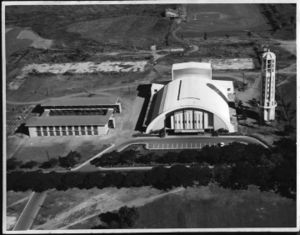
The budget goal for the tower was around 90,000 Php and 21, 706 Php was accumulated by April 1952. President Elpidio Quirino donated a thousand pesos and Professor Juan Nakpil, the architect for the tower, donated five thousand pesos in memory Dr. Ariston Bautista Lin. Other donors are Vice President Lopez, Eugenio Perez, the 1949 graduating class, inter-fraternity council, the UP Student Council, UP Alumni Chapters Laguna and Tarclas, Former regent Jose F. Zamora, Juan Carlos, The College of Forestry Alumni, Philippine Alpha Chpater of Pan Xenia, an anonymous donor, and many others.
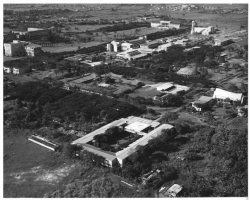
Dutch Carilloneur Adrian Antonisse, Jr. delivered the bells on behalf of Van Bergen Bell. Chimes and Carillon Foundry Company on June 1952 and the last bell was placed on July 11, 1952. The 45-bell carillon was the first of its kind in Southeast Asia and they cost seventy thousand pesos. Finally, Elpidio Quirino inaugurated the Carillon Tower at August 1, 1952 and the entire structure was dedicated to Philippine President Manuel L. Quezon. The UP Conservatory of Music also presented Antonisse at a Carillon concert on August 3, 1952 and he was also given a farewell concert on August 14. Carilloneurs Eva Gonzales and Wesley Tubuyoyong took turns in playing the bells at the tower that same year.
III. Structure and Design
Structure Overview
Generally constructed for bell towers,carillons are the heaviest of all extant musical instruments. The bells are usually made from bronze (80% copper + 20% tin) to produce perfect tone and clarity. Bronze is also much less prone to corrosion and much harder than brass thereby allowing carillons to retain its quality for decades. Carillons are connected through wires to the playing cabin where the clavier is installed. The playing cabin is positioned directly below the bell-chamber so the clavier can be placed in the optimum position relative to the transmission system. The entire system is then housed inside a tower to protect and support the instrument.
The Tower
The tower which houses at its highest level the bells of the University of the Philippines Memorial Campanile is a 130-feet-tall structure. It was built under the supervision of architect Juan Nakpil, who was hailed as National Artist for Architecture in 1973. The funds for its construction were provided by the UP Alumni Association and certain donors.
The exterior walls of the tower are painted with cream and maroon. It has a very stable foundation and has a system of vertical lines (eight outside, four inside) supporting the structure. The top portion of the tower is an open bellchamber with a small dome ceiling. It houses and displays the bells to the public. A sight of an endless narrow spiral staircase skyward through 5 landings could be seen in the building’s interior. During the First Quarter Storm in 1970’s, the UP Carillon was used as a watchtower by student activists—its unusual height provided the activists a panoramic view of the campus, which enabled them to spot military trying to barge in.
The Bells
46 bells were originally installed at the top portion of the tower under the supervision of Professor Adrian Antonisse Jr., a Dutch carilloneur and director of Veendammer Muziekschool in the Netherlands. Those bells were casted by Van Bergen Bell, Chimes and Carillon Foundry. Some of the bells were named after individual donors. On the largest bell—weighing about 5 tons—was embossed the names of the officers and the members of the board of directors of the alumni association. The last bell was set place on July 11, 1952.
These bells were tuned to the intervals of the chromatic scale similar to a piano, and having a range of three octaves or more. The bell which has the lowest pitch can weigh many tons. The smaller the size of the bell means the higher the pitch.
The classic method of playing the carillon is by striking a keyboard called a “clavier” which is similar to an organ except that it uses wooden pegs. According to Prof. Antonisse, one to two years of devoted study is necessary to master the instrument and that it also requires a great deal of muscular effort to play the instrument because the fists (rather than fingers) are used in striking the keys. Each key of the clavier is connected to the clapper of the corresponding bell by means of wires and cranks. Those clappers are sufficient to bring out the full volume of sound required for carillon playing. Pedals are also attached to the levers connected with the heavier bells so that these can be played by foot.
However, as part of UP Alumni Association’s project to restore the UP Carillon in 2008, these 46 old bells have been replaced by 36 new bells that were manufactured by Royal Bell Foundry Petit & Fritsen B.V. Holland. Aside from that, recent development has also allowed for an alternative way of playing the carillon by means of an automatic machine which enables the carillon to play at pre-set hours. The old bells are currently on display at the lobby of the University Theater.

| First Five Carilloneurs |
|---|
| Adrian Antonisse Jr. |
| Wesley Tubuyoyong |
| Eva Gonzales |
| Jerry Dadap |
| Tony Regalaria |
Table 1 shows the first five Carilloneur of the University of the Philippines. Currently [2011-2012], U.P. Carilloneurs are Malvin Bethooven Macasaet, Bachelor of Music [BM] Conducting graduate pursuing his 3rd degree in BM in Voice, and Jesper Colleen Mercado, BM Piano, both from the U.P. College of Music.
IV. Symbolisms and Struggles
Loyalty and Connection Between Generations
Since it was the alumni association who mainly contributed in the construction of the Carillon, it was established that the tower symbolizes the alumni spirit of love and loyalty for the university. As said by Juan Nakpil, the Carillon will serve as the emotional and spiritual link between the students, faculty, and alumni of the succeeding generations. He also added, “It will be a voice speaking to us [in] the midst of our campus – not from a distance.”
Extravagance
Though UP Carillon has been a symbol for alumni’s labor of love, it did not escape criticisms regarding its formation and structure. During the time of its construction, the state university was also suffering from an immense financial difficulty brought about by the war. Because of this, some sectors of the university objected to the formation of the Carillon, calling it a symbol of extravagance instead of loyalty. They contested that the money spent for its construction should have been allotted in solving the monetary problems that plagued the university.
In response to this, the editor of the Philippine Collegian during that time wrote: “We do not look at it that way. To us, the Carillon is a gift of the alumni and is symbolic of their regard to the Alma Mater. To us, the Memorial Campanile is the expression of their loyalty to the cause of education which the University is dedicated. That to us is the Carillon. If loyalty ever be a luxury then the Carillon and all that it stands for is luxury, indeed.”
Most of the University Officials believed that the Carillon symbolizes very important ideas and concepts that are priceless and are worthy of the enormous amount spent for its construction.
Being Tilted
The Carillon became sparked interest not only because of its opulence but also because of the assumption that the structure is tilted. During that time, students of the university hoped to have another leaning tower like that of the Pisa in Italy. However, a study made by a group of engineering professors proved that it was just an optical illusion. It was only after this study that all the clamor ceased.
Out of Tune
Aside from the fact that the bells are tuned in chromatic intervals and have a range of three or more octaves, the overtones and the harmonics produced by the bells are also arranged in an order quite different from those given by the strings or by an organ. Because of these factors, listeners who are not familiar with the Carillon would think that our bells are out of tune.
Defending the Carillon, Arthur L. Bigelow said, “In contrast to other producers of musical tone, endowed by nature with a major third, the third of the bell is minor. It is this particular overtone which gives to the bell its plaintive note, so characteristic and so distinctive from all other instruments.”
Truly, before one can fully appreciate the music of the Carillon, he must first learn to distinguish the humtones from the overtones. As what Prof Antonisse has said in one of his lectures, “You just don’t take Carillon Music. It is entirely different from other forms of music.”
Timelessness and Identity
This all being said, the Carillon stands tall and proud to this day. Despite the criticisms and calamities that it has seen throughout the years, the its legacy (and that of the alumni who have contributed to its building and rehabilitation) lives on. The Carillon tower is a permanent landmark and is arguably as "UP" as the other famous spots within the campus--thereby securing its place in history and identity of the university.
V. Restoration
Due to age and neglect, the Carillon fell silent through the years. Though the tower remained firm and robust, the Holland-made bronze bells went out of tune and the clavier crumbled over time. It was during the Lantern Parade in 1988 that the Carillon was last heard. Since then, the tower had been used as a stockroom, an art studio, and other various purposes. Previous restorations fell short of the funds needed for a complete overhaul.
The U.P. Alumni Association [UPAA] thought of bringing back the "Bells of Diliman" in time for the University's Centennial Celebration in 2008. During the 92nd Alumni Homecoming in June 2005, the UPAA Board of Directors officially launched the U.P. Carillon Restoration Project.
The Projet Committee's main objectives included the following: [1.] to restore the campanile, the tower, and the surroundings, which involves technical evaluations, fund raising, actual repairs and replacements, and the landscaping of the immediate environs; and [2.] to institutionalize the Carillon's operation and maintenance. Aside from preserving the bells' musicality and the physical upkeep, the project included maintaining a scholarship to ensure the availability of a steady pool of well-trained carilloneurs. Below are some of the renovations and changes made4:
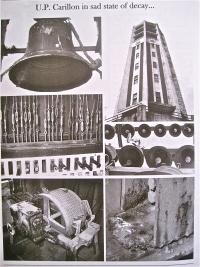

1. Clavier. The old clavier keyboard instrument was replaced with a new one made of oak wood and designed for heavy-duty performances.
2. Computerized operation. In addition to manual playing of the clavier, it is now hooked-up to a master clock, a synthesizer, and a computer. This enables the bells to be played automatically at specific times of the day.
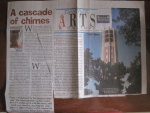

3. Steel frames and other parts. The steel frames where the bells are suspended were refurbished. Other important parts such as clappers, cables and steel wires, turnbuckle nuts and bolts, spindle springs, and miscellaneous items were replaced.
5. Tower structure. Both the inside and the outside walls of the Carillon tower, the flooring and other concrete structures were repaired, cleaned, and repainted.
6. Landscaping. The areas that surround the Carillon tower were cleaned, grass and flowering plants will be placed in accordance with a well laid-out plan.
7. Carillon Plaza. The outer surrounding areas encircling the Carillon tower were transformed into a flat amphitheater-like formation where concerts and musical performances could be held.
Past minor repairs were also done in 1977 for the University's Silver Jubilee and in 1982 for the University's Diamond Jubilee.
VI. Other Projects
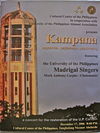
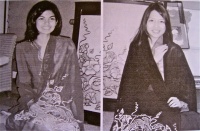
Along with the restoration came various projects and events for the U.P. Carillon Tower. One project is the "Kampana: Pagsamba... Pagbabago... Pagdiriwang" featuring the University of the Philippines Madrigal Singers5 [Madz] held on December 17, 2006 at the Cultural Center of the Philippines [CCP], Tanghalang Nicanor Abelardo. The concert was not planned, hence, it was a coincidence, when Mark Anthony Carpio, choirmaster of the group, conceptualized a Christmas concert about bells of worship, bells of change, and bells of celebration. It was a surprise to the UPAA, and thought of buying one of the Madz's concerts as a fund raiser for the restoration of the U.P. Carillon. In line with that, U.P. Coeds don the Araceli Limcaco-Dans designed shawls for the Kampana concert, that is, with a callado painting.
VII. Bibliography
Cabatuando, Patria. "The Musical Tower". The Philippine Collegian. 14 October 1967.
“Carillon.” UP Newsletter 19 October 1973. A1. Print.
"Carillon on the Diliman Skyline". The UP Bulletin. August 1949. A1. Print.
"Carilloneur Speaks on Bells and Music". The UP Bulletin. July 1952. A1. Print.
“Legend of the Bells.” The UP Bulletin September 1952. A1. Print
Mendoza, Rene E. "The Carillon Story". The Carillon Overtones. March 1957. A1. Print.
Nakpil, Juan F. "The Bells of Diliman."
The New Grove Dictionary of Music and Musicians. Ed. S. Sadie. 3 Vols.
"Now on its way are the UP Carillon Bells". The UP Bulletin, Alumni Homecoming Volume . April 1952. A1. Print.
Philippine Daily Inquirer 5 December 2007. A1. Print.
Philippine Star Lifestyle 12 September 2005 A1. Print.
"Quirino Donates P 1,000 to Carillon". The UP Bulletin August 1949. A1. Print.
Rivera, Flora Zarco. "The UP Carillon Bells". UP Alumni Reunion Yearbook. 1953. Print.
"Save The U.P. Carillon: A Centennial Project of the U.P. Alumni Association". Pamphlet. 2005. Print.
Valmero, Anna. "Restored UP Carillon serenades students once more". Yahoo! News Philippines. 18 April 2011.
The UP Bulletin January 1950. A1. Print.
Map
<googlemap lat="14.655216" lon="121.068091"></googlemap>
See Also
- Public Art at UP Diliman
- [1]Standard for Constructing Carillon Towers
- U.P. Carillon Music and Photos [Before and After the Restoration] http://www.youtube.com/watch?v=BnukWQqbqzY
- Inquirer.net [2007] [[2]]
- Inquirer.net [2008] [[3]]
- Inquirer.net [2011] [[4]]
Footnotes:
1 as per all write-ups of the U.P. Alumni Asociation or UPAA [booklets, pamphlets, press releases, etc.]
2Jose Y. Dalisay Jr. (born January 15, 1954) is a Filipino writer. He has won numerous awards and prizes for fiction, poetry, drama, nonfiction and screenplay, including 16 Palanca Awards. See also Jose Dalisay
3 according to www.dollartimes.com
4 for more information, you may visit www.upcarillon.org
5 The Philippine Madrigal Singers or Madz was organized in 1963 by National Artist Professor Andrea Veneracion. The choir is one of the most awarded, having consistently won all the top prizes in most of the world's prestigious choral competitions.